#cosimo canale
Text


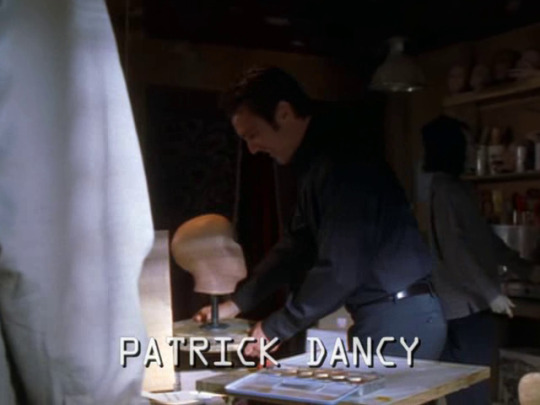
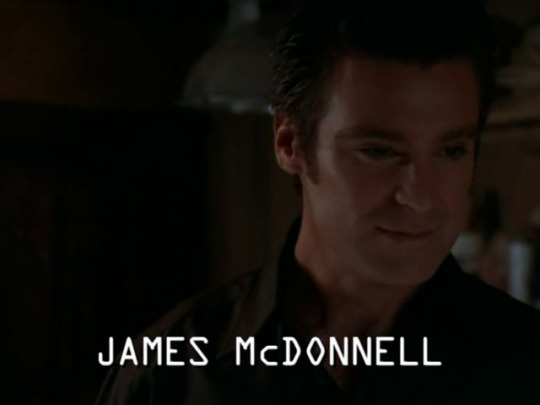


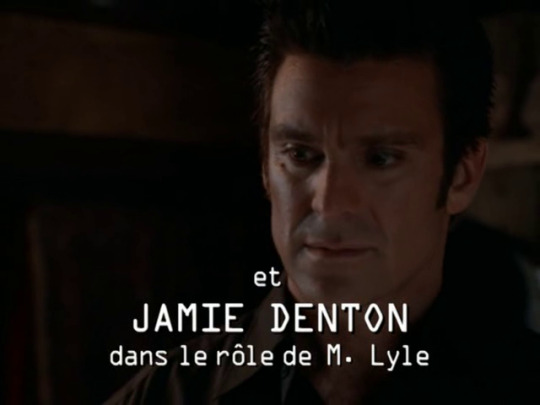



Captures de l’Ep. 4.03 : Le Vol de l'Ange / Angel's Flight (1999) de la série Le Caméléon (V.O. : The Pretender).
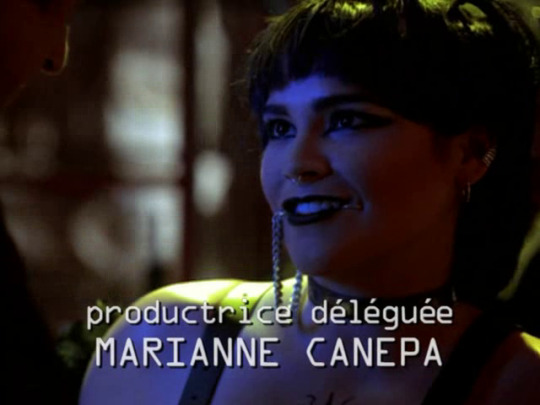
Distribution :
- James McDonnell, qui avait déjà croisé l'actrice Kim Myers dans l' Ep. 1.16 (1987) de la série La Loi de Los Angeles, et qui retrouvera l'acteur James Denton dans l'Ep. 1.16 (2002) de la série Philly, puis dans les Ep. 6.01 (2009) et 6.11 (2010) de la série Desperate Housewives;
- Cosimo Canale, qui a retrouvé l'acteur Jason Brooks dans le TVfilm Un Homme Trop Parfait (2013)

Jarod (arrivant devant un camion de glaces) : "Je voudrais 2 boules à la vanille avec des éclats de noisettes s'il vous plaît."
Marchand de glaces (en train de nettoyer son camion, éponge savonneuse à la main) : "On est pas encore ouvert."
Jarod : "Oh mais j'ai de l'argent vous savez."
Marchand de glaces (agacé, regardant sa montre) : "Ecoutez, il n'est que 7h et demi du matin ! ... (désignant une direction de la main) Allez prendre votre petit-déjeuner en face ..."
Jarod : "Etant donné qu'il y a du fer, du calcium et du lactose dans la glace à la vanille, des sucres lents énergétiques dans le cornet et des fibres dans les noisettes, il est clair qu'en réalité on absorbe plus d'éléments nutritifs dans une ... glace au goût surprenant que dans 2 oeufs au plat avec du bacon et du café."
Marchand de glaces (fatigué) : "Vous êtes pas un peu dérangé ?"
Jarod : "Non (très souriant) ... j'adore les glaces (très heureux)."
Marchand de glaces (blasé) : Ah ... ouais ..."


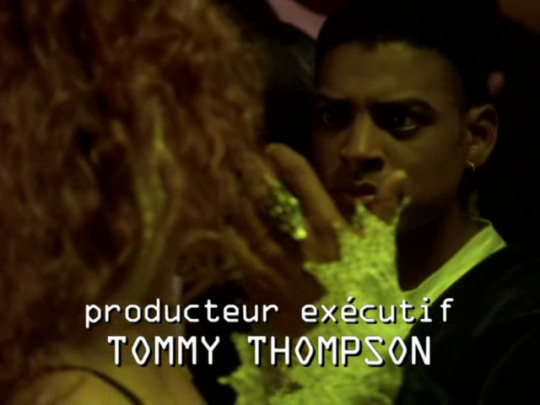

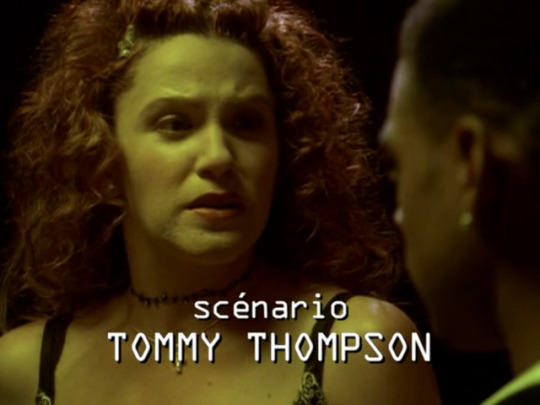
Saison 4 : Episodes 01 - 03 - 04 - 05 - 07 - 08 - 09
- 11 - 13 - 15 - 16 - 18 - 19 - 20.
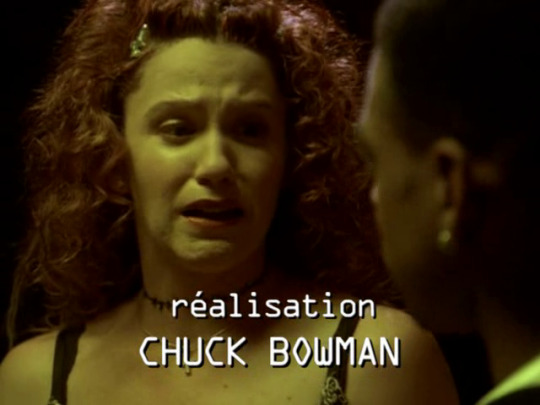
source : imdb
#le cameleon#the pretender#the pretender lives#1999#glace#montres#saison 4#season 4#episode 3#le vol de l'ange#angel's flight#cosimo canale#James McDonnell
2 notes
·
View notes
Text
Destaques na TV – Semana 29/maio 4/junho
Medice:O Maganifico nova série estréia no canal TNT Séries no sábado com dois episódios.
Na Florença do início do século XV, Cosimo de Medici (Richard Madden) acaba de assumir o Banco de Medici após seu pai Giovanni (Dustin Hoffman) ser misteriosamente envenenado. Sendo o próximo da dinastia, esse jovem logo percebe que com grandes poderes vêm grandes responsabilidades.
Domingo temos a estreia…

View On WordPress
2 notes
·
View notes
Text
Canale navigabile Pisa-Livorno detto “dei Navicelli”
Le prime notizie del canale dei Navicelli che partendo a valle della città di Pisa giunge a Livorno risalgono alla fine del XVI secolo, all’epoca di Cosimo I de’ Medici, quando Pisa e Livorno erano ormai sotto il dominio di Firenze. Fu allora che venne progettata la costruzione di un canale navigabile che collegasse Livorno a Pisa e poi a Firenze lungo il corso dell’Arno fino al porto del…

View On WordPress
#Canale dei Navicelli#Canale navigabile Pisa-Livorno#collegamenti fluviali#porti fluviali in Toscana
1 note
·
View note
Text
Leea Clem - Il videoclip di “acid”
Esce il videoclip del primo singolo estratto dall’album “moving on” della giovane artista

Il videoclip di “acid” diretto da Fabio Colonna (con Sela Tommasi) in anteprima nazionale sullo storico portale del Mei. Un video dalle forti tinte pop con riferimenti retrò dall’animo fresco e di tendenza ideato dalla stessa artista (Styling CityModa Italia - Hairstylist Giusy Murro). Giovanissima Leea Clem, cantautrice pugliese di 17 anni che inizia ufficialmente il suo percorso discografico con un disco dal titolo “Moving on” prodotto da Martino Schembri con la produzione artistica di Cosimo Taurino, per DMB Management di Rory Di Benedetto, in distribuzione Sony Music Italia e realizzato grazie al prezioso sostegno di Puglia Sounds. Album e singolo sono disponibili sui principali stores digitali e il videoclip sul canale ufficiale YouTube dell’artista.
Leea Clem è una cantautrice pugliese di 17 anni che si è affacciata al mondo della musica da tutti i punti di vista sin da piccola. Ha iniziato a scrivere durante la quarantena del 2020 facendosi poi conoscere dal pubblico nell’estate del 2021 con la pubblicazione su tutte le piattaforme del suo primo singolo “A Universe Apart”. Nel 2022 pubblica altri due singoli, “Fool For You” e “Better With You”, tutti rigorosamente scritti da lei. E a marzo del 2022 esce “acid”, singolo di lancio del suo album d’esordio “moving on”. Nei suoi brani porta temi facilmente comprensibili a tutti, in quanto parla dei rapporti personali e delle emozioni che si costruiscono attorno ad essi. La scelta dell’inglese è dettata dal sogno di poter arrivare con le sue emozioni al pubblico non solo italiano, ma di tutto il mondo.
Spotifyhttps://open.spotify.com/album/64aM6dxc6iq6vgsTqgiAUo?si=OStSdHH5SPqpbOPrpmyJKw
TikTok https://www.tiktok.com/@leeaclem?_t=8aJEVpyQEm3&_r=1
Instagram https://www.instagram.com/leeaclem/
Facebook https://www.facebook.com/leeaclemmusic
youtube
0 notes
Text
Livorno
Scommetto che molti di voi conosceranno Livorno grazie al fatto che è una nota città portuale e magari proprio da lì siete salpati alla volta della Corsica o della Sardegna. In effetti, anch’io sarei dovuta partire da lì per una vacanza un po’ diversa dal solito, nello specifico un trekking sull’isola di Capraia. Purtroppo, con mio dispiacere, il tour operator non è riuscito a raggiungere il numero minimo di partecipati e quindi ho dovuto rinviare il viaggio “attivo” a data da destinarsi. A quel punto dovevo disdire l’hotel prenotato autonomamente dato che il luogo di ritrovo del gruppo sarebbe stato direttamente il porto di Livorno, ma... perché annullare tutto? Perché non partire alla scoperta della città?
Ecco come ha avuto inizio il mio viaggio a Livorno che, ve lo anticipo, mi ha fatto scoprire dei luoghi davvero interessanti e un po’ anche inaspettati.
Uno dei primi luoghi che s’incontrano avvicinandosi al centro è l’ampia Piazza della Repubblica seguita dal Cisternino e poi da Piazza Grande dove si trova il Duomo che conserva il “Cristo coronato di spine” di Beato Angelico. Non molto lontano, lungo il Fosso Reale sono situati il Mercato centrale ancora in piena funzione, le Scuole Benci e l’ex chiesa della Congregazione olandese-alemanna.


Il cuore storico della città è il quartiere Venezia Nuova che è sorto a partire dal 1629 come “isola” mercantile percorsa da canali. Come è facile intuire, il suo nome deriva proprio da tecniche e maestranze provenienti da Venezia.

Qui si trovano diversi palazzi settecenteschi come il Palazzo del Monte di Pietà ed il palazzo delle Colonne di marmo. Due sono invece le chiese importanti: la chiesa di S. Caterina, che allo spoglio ed incompiuto esterno contrappone un interno decorato con stucchi ed affreschi oltre all’Incoronazione della Vergine del Vasari, e la chiesa di S. Ferdinando Re, anch’essa con la facciata incompiuta, la cui opera più rilevante è il complesso scultoreo degli Schiavi liberati di Giovanni Baratta.


All’inizio del XVI secolo i de’ Medici avviarono un'importante trasformazione delle torri e delle strutture fortificate preesistenti dando vita alla Fortezza Vecchia.
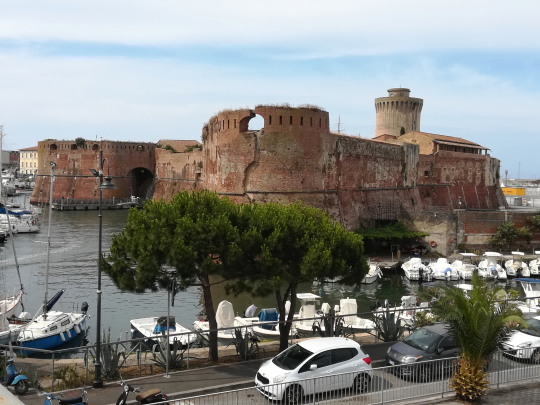
Qui il granduca Cosimo I de' Medici realizzò anche un palazzo per farne la propria residenza durante le sue frequenti visite alla città mentre il suo successore, Francesco I, fece costruire una palazzina rivolta verso il mare ed una piccola cappella dedicata a San Francesco. Purtroppo la seconda guerra mondiale ha causato profondi danni alla struttura che recentemente è stata oggetto di restauri. Il visitatore ha modo di vedere alcuni esemplari di fauna che qui trovano rifugio, scorci sul canale oppure ammirare da lontano il veliero Amerigo Vespucci.

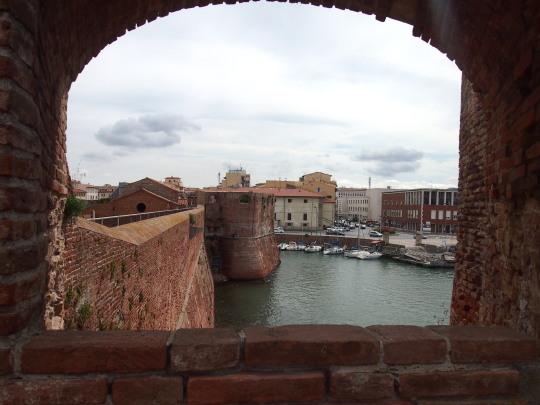

Verso la fine del Cinquecento venne costruita la Fortezza Nuova su disegno di Giovanni de’ Medici, Vincenzo Bonanni e Bernardo Bontalenti. Il progetto prevedeva un abitato chiuso da una cinta muraria e da un sistema di fossi a forma pentagonale a cui, successivamente, è stata aggiunta la fortezza.
Trattandosi di una città portuale, ho fatto un salto anche al Porto mediceo (il porto turistico) ed alla Darsena Vecchia, ora ormeggio di pescherecci ma in origine primo porto mediceo dal quale partirono Amerigo Vespucci e Giovanni da Verrazzano per i loro viaggi di scoperta.

Poco distante dalla Darsena si trova uno dei simboli più noti della città: il monumento ai Quattro Mori. Esso raffigura Ferdinando I de’ Medici e celebra le vittorie del Granduca sui corsari barbareschi che razziavano le coste toscane. A questo monumento è legata una credenza popolare di buon auspicio: sembra che esista un punto della piazza dal quale è possibile osservare il naso di tutti e quattro i mori contemporaneamente... se riuscierete a vederli sarete baciati dalla fortuna! ;-)


Un modo alternativo per conoscere la città e i suoi canali è prenotare un giro in barca per ammirare Livorno da un’altra prospettiva: per farlo recatevi agli Scali della Darsena e... buona navigazione!
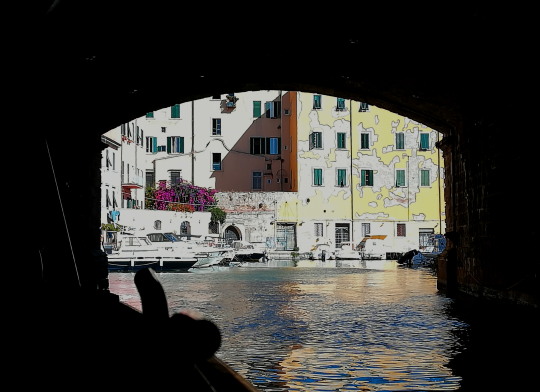

Il viaggio a Livorno continua...
#viaggi#livorno#piazza della repubblica#cisternino#piazza grande#duomo#mercato centrale#quartiere venezia nuova#chiesa di santa caterina#chiesa di san ferdinando re#fortezza vecchia#fortezza nuova#porto mediceo#darsena vecchia#monumento ai quattro moli#navigazione#canali
12 notes
·
View notes
Text

La penisola di Roca Vecchia
Sede di importanti scavi archeologici, la torre di avvistamento cinquecentesca, le rovine del castello a picco sul mare, il santuario della Madonna di Roca del XVII sec. e le due grotte Poesia dal greco, "sorgente d'acqua dolce", note come grotte della Poesia. Queste ultime, in particolare, distanti circa 60 metri l'una dall'altra, sono delle grotte carsiche cui sono crollati i tetti; l'acqua del mare giunge in ciascuna di esse attraverso un canale percorribile a nuoto o con una piccola imbarcazione. La più grande delle due ha una pianta approssimativamente ellittica con assi di circa 30 e 18 metri e dista dal mare aperto una trentina di metri. La Poesia Piccola ha assi di circa 15 e 9 metri ed è separata dal mare aperto da una settantina di metri in linea d'aria. La sua notevole importanza in ambito archeologico è legata al rinvenimento nel 1983 da parte dell'archeologo Cosimo Pagliara, di iscrizioni: messapiche, greche e latine sulle sue pareti, da cui è stato possibile stabilire che la grotta fosse anticamente luogo di culto del dio Taotor o anche Tator, Teotor, o Tootor.
1 note
·
View note
Note
When I first watched the scene with Cosimo and the Duomo the first thought that passed through my head was : " WOW that's so beautiful!"
The second one was : " Who is more beautiful, Cosimo or the Duomo?"
ME the majority of this show is just pretty people being pretty in pretty locations and i’m not mad about it
giulio and carlo are my underrated medici boys the only guys in the vatican that i stan
i agree but if we’re talking the vatican then this is giovanni erasure!! the fact that you forgot about him altogether tells us that he’s even more underrated than giulio and carlo jfkgh
how did you first get into medici?
hmm i really don’t remember! i have been here since almost the beginning, i can tell you that much. while i didn’t get into the fandom (or know there WAS a fandom) until s2 i did watch and love s1 in i think summer 2017. but i don’t remember how i heard about it or decided to watch, i guess i just stumbled across it on netflix one day and gave it a shot
what are some reccs similar to medici please
i can’t think of many that i’ve seen, but it’s often paired together with the borgias since that takes place in renaissance italy right after medici’s timeframe and will show you the medici getting kicked out of florence, caterina sforza later in life, etc. there’s showtime’s the borgias on netflix which i liked, and there’s also canal+ borgia which i haven’t seen but i’ve heard good things
what medici book do you recommend reading?
the only one i’ve read is lauro martines’s april blood: florence and the plot against the medici which is excellent! highly recommend
6 notes
·
View notes
Text
"A historical chronological depiction from an imaginary Italy: a guess the reference game". 100th Anniversary
Unknown: Pdor Mythos
Unknown: Appears the superheroes gene "Vip"
10'000 A.C: In the Mediterranean basin lives a society of amazoness
89 A.C: Marcus Aemilius Scaurus is born
71 A.C: Spartacus leads a slaves rebellion
55 A.C: Tros of Samothrace takes the parts of the Breton resistance against the Roman conquest of Britain
50 A.C: Julius Augustus Caesar's complete conquest of Gaul finds resistance against a village in Armorica
11 March 44 A.C: Julius Augustus Caesar is murdered
80: Barbarian Ardarico's conquest of Rome miserably fails; Flavian Amphitheatre is inaugurated and Timo becomes a gladiator
128: Architect Lucius Quintus Modestus repeatedly travels through time until the 21st century and visits the modern Japan
536: Martinus Paduei, a mysterious genius ahead of his time, leaves his mark in history as inventor, business owner, strategist and politician
569: King Alboin befriends and welcomes a sly and smart peasant to his court in Verona
726: Girolama Pellacani is raped by the Longobards
1050: Brancaleone of Norcia is born
1076: The saint hermit of Bismantova is sent to Aquileia in search of allies at the behest of Pope Gregory VII, but is hindered by the devil
1080: Brancaleone of Norcia takes part at the first crusade
1141: Baudolino is born
1150: Various supernatural events take place at the castle of Otranto
1249: The company of Selva Bella participates at the mission to free Enzo of Sardinia
1271: Marco Polo begins his travel toward the Orient
1280: Marco Polo reaches the court of Kublai Khan and tell him about the 55 cities
1295: Marco Polo returns to Venice
Early XIV Century: To win the maritime war against Venice, the Genoese captain Luigi Gottardi builds the underground canal of Meloria
1300: Poet Dante Alighieri visits the afterlife in a week
1327: William of Baskerville is involved in a murder case sets in a benedictine abbey
15 April 1452: Leonardo da Vinci is born
1478: Takes places the quests of the "Company of the Gallows"
1506: Arte Spalletti becomes an artist
1534: Two english brothers find a passage for a subterranean world where the time flows more slowly and is populated by a society of pygmies
1537: During the battle of Turin a french soldier mysteriously survives to several deadly wounds
1570: To save her lover, war-prisoner at Famagosta in Cyprus, the duchess of Eboli wears an armor and under the alias of Captain Storm fights several battle against the Ottoman Empire
1595: The suicide of two lovers leads peace in a longtime feud between two Veronese families
1630: The black plague continues its killspread, Spanish local lord Don Rodrigo is found dead
1643: Nobleman Roberto de la Grive is presumed lost after a shipwreck in the Pacific Ocean
1650s: Alchemist Girolamo Fumagalli develops the basic technique of thanatography
1660s: Viscount Medardo of Terralba returns changed and maimed in a strange and impossible way from the Ottoman wars in Bohemia
1686: After losing his brothers during the Franco-Spanish war at the hand of Duke Wan Guld, the Lord of Ventimiglia Emilio of Roccabruna promises to avenge them and becomes the notorious Black Corsair
1711: A group of alchemists evoke a demon to gain eternal life
1713: Sir Frances Varney commits suicide by throwing himself into Mt. Vesuvius
7 January 1730: In Siena is approved the Notice of Violante of Bavaria
1741: Antonio Salvatore "Totò" Sapore invents pizza to bring peace between French and Neapolitan armies
1750s: Armando "The Scorpion" Catalano seeks the Templar treasure
1762: Reverend Yorick, friend of Tristram Shandy, visits France and Italy for a health issue
1764: Father Schedoni is involved in a conspiracy
1767: Cosimo Piovasco of Rondò, future baron of Ombrosa, climbs up a tree and will live his entire life on the trees
18 October 1775: Carlo Altovivi is born
1790: Scandal of the fallen noble family Mazzini
1798: Nobleman and soldier Fabrizio del Dongo is born
25 March 1799: Jacopo Ortis dies
1801: Vampire Giovanni Nosferatu is born
1812: Soldier Lazzaro Scacerni is one of the survivors of the retreat from Moscow and, after returning in Italy, becomes a wealthy miller
1825: History professor Mercurio Loi disappears
1826: Dr. Weiss solves the Fritzheim case
1829: A frenchman discovers the Spada family's treasure located in Montecristo Isle
1850: Count Isidor Ottavio Baldassarre Fosco reaches England to plan a political conspiracy
1855: Princess Teresa Uzeda of Francalanza dies
1860: The wooden puppet Pinocchio becomes a real children
1863: Three persons, claiming to be part of a scientific expedition, are spotted been ejected from Mt. Stromboli
1864: Countess Marina Vittoria Crusnelli of Malombra gets possessed
1870: Enrico Bottini is born; Edwin Drood mysteriously disappears leaving a secret still unsolved
1874: As social experiment some prisoners are released in a deserted island to create a self-managed isolated colony; Arsène Lupin is born
1878: Rosso Malpelo dies
1885: A frenchman from Tarascon survive to a fall during an attempt to reach the peak of Mt. Blanc
1887: Professor Sandrelli develops a substance that cancels gravity
1888: Full of remorse, baron Carlo Coriolano of Santafusca admits of being a killer
1889: Masked hero "Hidden Face" and Ugo Pastore take part at the Treaty of Wuchale; Escorted by english explorer Adam Wild, Count Narciso Molfetta explores Africa
7 December 1891: Vito Andolini is born
1893: Marco Pagot is born
1895: Architect Emilio Varelli starts the construction of the Three Mothers' manors
September 1897: Giannino "Gian Burrasca" Stoppani is born
1898: The suppression of Milan riots are sabotaged by Tommaso Reiner
1899: Vadim Vadimovich N. Storov is born
29 May 1899: Giuseppe "Peppone" Bottazzi is born
30 May 1899: Don Camillo Tarocci is born
Early 1900s: Paolo Zeder hypothesizes the "K-Zone" theory; Actress Maria Sarti gains notoriety under the stage name Ninì Tirabusciò
1910: Architect Emilio Varelli finishes the construction of the Three Mothers' manors; Aldovino reaches the moon to marry the princess Yala; Count Emilio Ponticelli partecipes at the Daily Post air race
1911: Famous composer Gustav von Aschenbach dies during a holiday in Venice
WWI: Flying ace Marco Pagot turns into an anthropomorphic pig and assumes the identity of the bounty hunter Porco Rosso; Aviator Luciano Serra, aviator Matteo Campini, Private Lazzaro Scacerni and Private Italino take part at the conflict; Baron Cesare Stromboli helps the Triple Entente; Private Piero dies
1915: Air piratess Filibus terrorizes southern Italy performing several thefts
15 October 1915: Emilio Largo is born
1919: A man dressed in red and constantly speaking in rhyme becomes one of the richest italian
1920: Famous film director Guido Anselmi is born; Pugilist Furio Almirante emigrates in America
1927: Dr. Artemio Zacchia founds a medicine and natural science academy and starts his studies on immortality
March 1927: Detective Francesco "Ciccio" Ingravallo solves the Via Merulana mystery
June 1929: Fascist militia suppression at Fontamara
1930: Dominetta Vitali is born; Scientist Pier Cloruro de' Lambicchi creates a substance that gives life to the images
1933: Gastone Uliani investigates the faun's case
17 July 1934: Ugo Fantozzi is born
1935: Italy's invasion of Ethiopia is obstacled by local spy Bara
1936: Lawyer Gino Motta is locked up in an asylum after claiming that in the sea near Levanto lives a colony of mermaids
29 September 1936: Lolito B. Lassica is born
1938: Benzino Napaloni signs an alliance with Adenoid Hynkel; The launch of
hierarch Gaetano Maria Barbagli's expedition for Mars takes place; Primo
Cossi chooses to undergoes at the EPRA experiment; Dr. Emilio Lizardo and Professor Tohichi Hikita build the oscillation overthruster, Lizardo trying to enter into the 8th dimension becomes insane; American archeologist Martin Padway travels through time until 535
1939: Count Zero becomes a fascist agent; Film director Salvatore Di Vita is born
10 May 1939: Hierarch Gaetano Maria Barbagli and his troop land on Mars
WWII: Captain Alberto Bertorelli, Captain Antonio Corelli, Major Oscar Pilli, Sergeant Nicola Lo Russo, Lieutenant Gino Rossati, Marmittone and Galeazzo Musolesi take part at the conflict; Partisian Johnny loses his life; Partisan Natalino "Capellone" Tartufato saves the life of the english spy Charles Harrison, Private Antonio is considered as straggler in Russia
1940s: Marcella Valmarin becomes a famous actress under the stage name of Alba Doris
25 December 1942: Photographer Valentina Rosselli is born
1943: The Finzi-Continis family is exterminated in a German Nazi lager, along with other jews
1944: In a hidden palace in the Republic of Salò, tortures takes place by hand of four wealthy personality of the republic
1945: End of World War II in Europe and the prison camps are freed, Giosuè Orefice is among the survivors
3 March 1945: Nicola "Nico" Giraldi is born
6 July 1945: Roberto "Rocky" Balboa is born
1950s: Bianca Castafiore is recognized as one of the best soprano in the world; Amelia Bonetti and Pippo Botticella become two renowned tip-tap dancers
6 September 1950: Salvo Montalbano is born
1952: In a laboratory comes to life a creature made of rubber
1953: Michele Apicella is born; During a diplomatic visit in Italy a princess escapes through the streets of Rome
1955: Criminal and con artist Mr. Ripley lands in Italy
1956: Painter Buono Legnani commits suicide
1957: Exorcist Don Zauker lands in Livorno
19 September 1958: Renato "René" Ferretti is born
1959: Topo Gigio debuts and becomes a television star; Detective Nero Wolfe moves to Rome after some "problems" with FBI
1960: Authoress Enrica Valldolit wins the Nobel Prize in Literature
1961: A british spy agent kills the terrorist Emilio Largo; A cemetery man has a close encounter with the Death
15 August 1962: A young university student loses his life in a car accident caused by an overtaking
1963: Medic Duca Lamberti loses his license and is imprisoned for practicing euthanasia; Calimero is born; "The Alphabet Killer" is caught
1966: Criminal Mastermind "The Fox" evades from prison
4 October 1967: Deboroh La Roccia is born
1968: Diabolik is presumed dead; Primo Cossi wakes up from hibernation and becomes a hitman related to the events of the Years of Lead
1969: A british criminal gang robs the FIAT industry
1970s: A criminal uses the sewer of a metropolis as hiding place and house; At Milan a group of bounty hunters form the C.T Association
1971: Fumagalli's thanatography is used to solve the four flies' mystery; Alberto Valle becomes the new Avio Motor CEO
1972: Somewhere in northern Italy, inside the Military Area 36, Professor Endriadi and his research team build the first AI
February 1973: Four men commits suicide through planteration in a villa near Paris
1 June 1973: A terroristic attack blows up the Madonnina statue atop Milan Cathedral
1974: Andrea Straniero is born; Approved the healthcare reform "C.M.G"; Camilla Cagliostri is born
1975: After months of shipwreck on a deserted island in the Mediterranean sea,
the wife of the industrial Lanzetti and a sailor are saved; The corpses of
the Crespi d'Adda cemetery are resurrected; At Rome, German psychic medium Helga Ulmann is brutally killed
1976: For having inflicts severe damages to the organized criminality all over Italy in just few years, mysterious killers murder the police commissioner Betti
1977: Virginia Ducci survives at a murder attempt thanks to her clairvoyance
1978: Science fiction writer Della Spigola is abducted by the martians of
Phobos; Discovered a breed of talking dog with a particular white fur with red spots; Famous chef Fausto Zoppi is killed by drowning; It ends the Filippo Carducci's kidnapping case; Riccardo Finzi begins his career as P.I
1979:
1980s: The ministry of the Great Hunt is founded;
1980: "Caterina" an American brand of robotic housekeeper goes on sale; Neapolitan camorra boss "The Marseillaise" and his gang are killed after a showdown; Rocky Giraldi is born, so named in honour of the famous boxer
12 August 1980: The Matchstick Man is spotted near the Abruzzi countryside
3 October 1980: Leonardo Zuliani is born
1981: The criminal known as "The Human Beast" loses his life in a gunfight
1982: The "K-Zone" theory is confirmed and Paolo Zeder is resurrected as zombie
1983: For the first time, alive people witness the "Palio di Siena of the dead contrade"; It is archived the case of the serial killer known as "The Killer Dwarf"; Naples F.C pays three billion for the acquisition of Brazilian footballer Paulo Roberto Cotequinho, he'll lead the Naples to the victory of its first championship four years later.
1984: Two men inadvertently travel through time back the 1492
August 1988: The first issue of "Bloody Eye" is published
1989: During a conference in Rome, experts try to discover the truth behind the Edwin Drood mystery; Deboroh La Roccia becomes Rat-Man
20 March 1989: Commissioner Corrado Cattani is killed in a mafia ambush
1990: FIFA World Cup scandal, the Italy team hires two pornstars to win; Salvo Montalbano becomes a police commissioner
1991:
1992: Sicilian gangster Johnny Stecchino uselessly resort to a person exchange to avoid death; During the annual Milan Film Festival, mystery fiction writer and amateur sleuth Jessica Fletcher resolves a murder case; During the quadrennial pallastrada world competition the St. Catherine prophecy comes true burning up the entire state of Gladonia
November 1992: Daria Marchesi is jailed for the Baldacci murder, thus Marino Strano becomes Bloody Eye's head writer
1994: "The Florence Monster" is finally arrested; A feud between two families ends with the use of a low-potential atomic warhead; After various vicissitudes experienced in India, Marco Donati is exposed at the Aquarium Berlin as "The boy with the gills"
1995: Marco Buratti aka "The Alligator" starts a new career as P.I.
1996: After his death Ugo Fantozzi returns to life until 1998
1997: Police agent Napoleone di Carlo abandons his profession and moves in
Switzerland
1999: Ugo Fantozzi is cloned; "The Fish in Love" becomes an international bestseller
2000s: Jimi Dini works at the development of his videogame "Nirvana"; Dr. Bartolomeo Zacchia continues his father's studies
2001: A romanian vampire is sighted in Rome
April 2001: Giorno Giovanna becomes the Gangstar of the mafia association "Passione"
2005: Police agent Rocky Giraldi enters in service
2006: Rise of nationalism in Italy brings to the birth of Captain Padania
July 2006: Activist Leonardo Zuliani disappears
2007: Mater Lacrimarum is killed
2009: During a spiritual séance, Gualtiero Marchesi conjures the Emily Ann Faulkner's spirit
2013: Long Wei becomes a local hero for the chinese communities in Italy; Celestine VI becomes the new pope
2014: An amateur gang of smart drugs dealers is arrested; Michele Silenzi gains superpowers
2015: Low-grade criminal Enzo Ceccotti gets superpowers and becomes the superhero Jeeg Robot; Arsène Lupin's grandson is spotted in Italy
2016: Benzino Napaloni is cloned; Intellectual Mario Bambea survives at his suicide attempt, contemporaneously begins the rise of popularity of the comedian Fabrizio "Bizio" Capoccetti
2017: In Calabria a farmer befriends a rare specimen of unicorn
11 September 2077: An asteroid falls in northeast Italy sweeping away Padoa, Vicenza and Verona while Venice is half submerged
|Cities&Places|
The Seven Cities
Meloria Canal
Gualdana Pine Forest
Nepente Isle
Stranalandia Island
Desolation Isle
Pescespada Island
Malapunta
Clerville
Porcionia
Bacteria
Kindaor
Gladonia
Tristalia
The Land of Toys
Gerolstein
Lotto Valentino
Bassavilla
Lancimago
Vigata
Montelusa
Loquasto
The 55 Invisible Cities
Pratofungo
Ombrosa
Pineta
Sagunto
Pista Prima
Frittole
Sevalio
Brigantes
Sompazzo
Monzurlo
Salsiccia
Acqua Traverse
Buffalora
Roccaverdina
Nofi
Norbio
Solara
Scasazza
Ponteratto
Idrasca
Giancaldo
Pieve Lunga
San Michele
Borgo Tre Case
Borgo Dieci Case
Accendura
|Fiction in Fiction|
Urban X (Pope)
Astrubal I (Pope)
Pius XIII (Pope)
Celestine VI (Pope)
Luke I (Pope)
Libero I (Pope)
Teomondo Scròfalo (Painter)
Dùdron (Painter)
Amos Pelicorti (Sculptor)
Jep Gambardella (Writer)
Cornelio Bizzarro (Writer)
Leo Cordio (Writer)
Ulisse Isolani (Writer)
Ubaldo Terzani (Writer)
Vincenzo de Fabritiis (Writer)
Thomas Prostata (Writer)
Giovanni Pontano (Writer)
Giuseppe Marchi (Writer)
Morgan Perdinka (Writer)
Antonio Casella (Writer)
Enrico Puzzo (Writer)
Arturo Vannino (Writer)
Edoardo Lasagnetta (Writer)
Ugo Redy (Writer)
Carlo Sperato (Poet)
Giancarlo Santini (Film Director)
Lippini Bros (Film Directors)
Gambalesta (Actor)
Enzo Melchiorri (Actor)
Franco Melis (Actor)
Saverio Crispo (Actor)
Marco Salviati (Actor)
Sofia Barlow (Actress)
Giorgio Fini (Tenor)
Carlo "Vitalis" Balzani (Tenor)
Tony Corallo (Singer)
Pat Rubino (Singer)
Luca Pappacena (Singer)
Quartetto Basileus (Band)
Martino Piccione (Guitarist)
Mariottide (Songwriter)
DJ Vomito (Rapper)
Bud "Bomber" Graziano (Boxer)
Franco Fibbri (Soccer Player)
Antonio Pisapia (Soccer Player)
Gli occhi del cuore ("The Eyes of the Heart") (Tv Series)
Medical Dimension (Tv Series)
La Bomba ("The Bomb") (Tv Series)
Redenzione ("Redemption") (Movie)
Paura d'odiare ("Fear to Hate") (Movie)
L'usuraio licantropo ("The Werewolf Usurer") (Movie)
Thor e le regine nude ("Thor and the Naked Queens") (Movie)
Il vortice equestre ("The Equestrian Vortex") (Movie)
La regina del pianeta nero ("The Queen of the Black Planet") (Movie)
La palude del caimano ("The Caiman Marsh") (Movie)
La vendetta del cobra ("Cobra's Revenge") (Movie)
I ragazzi del Bronx ("The Bronx Boys") (Movie)
Il caimano ("The Caiman") (Movie)
Cataratte ("Cataracts") (Movie)
Mocassini assassini ("Assassin Moccasins") (Movie)
Maciste contro Freud (Maciste Versus Freud") (Movie)
La mamma di Freud ("Freud's Mom") (Movie)
Natale con la casta ("Christmas with the Caste") (Movie)
La Febbra ("The Fever") (Movie)
La polizia s'incazza (Movie)
Sinite Parvulos (Movie)
Margas (Movie)
Il terrore di Parigi ("The Terror of Paris") (Play)
Space Queen Vega (Videogame)
Amedeo's Revenge (Videogame)
Il codice indecifrabile ("The Indecipherable Code") (Novel)
L'albicocco al curaro ("Apricot with Curare") (Novel)
La paura del giorno ("Fear of the Day") (Novel)
L'apparato umano ("The Human Apparatus") (Novel)
Evoluzione digitale ("Digital Evolution") (Novel)
Cortocircuito ("Short Circuit") (Novel)
Folgore su Policastro ("Thunderbolt over Policastro") (Novel)
La ninfa e il cadetto ("The Ninphe and the Cadet") (Novel)
Il pesce innamorato ("The Fish in Love") (Children's Book)
Bloody Mario (Comic Strip)
Bloody Eye (Comic Book)
Megaditta (Company)
Nosferatù (Company)
Finmor (Company)
Centovetrine (Company)
Auto Avio Motor (Company)
SOFRAM (Company)
Tekne (Company)
Wondercomics (Company)
Tondello Spa (Company)
Digitex (Company)
Sbav (Company)
Famburgher House (Company)
Trattoria Aldini (Company)
Smack-O-Mat Corporation (Company)
Partito Regressista (Politic)
Partito Socialista Unificando (Politic)
Italia in Marcia (Politic)
Grande Destra (Politic)
Longobarda (Football Club)
Borgorosso (Football Club)
Marchigiana (Football Club)
Olimpia (Football Club)
Eat it! (Product)
Fido Uomo (Product)
Io Cane (Product)
Pandoro Sauli (Product)
Cacao Meravigliao (Product)
Cioccolato Spagnoli (Product)
Marmellata Puffin (Product)
Acqua pulita (Product)
Coralba (Product)
Sarchiapone (Animal)
Colombre (Animal)
Jaguar Shark (Animal)
Tropelio (Animal)
16 notes
·
View notes
Text
Minette watches Medici, part 5 (Temptation)
- Such a scandalous episode. Very juicy. Much cheating. Not a fan.
- I am confused. Is that Venetian chick a courtesan, prostitute picked from the street, or a slave?
- Either way, she orgasms like only a woman on top of Richard Madden could. Meanwhile, it’s been about twenty years and Cosimo still fucks like he’s suffering from clinical depression despite being much less bummed out now. Maybe he just doesn’t like sex or something.
- Meanwhile, his wife is also offered a chance to cheat and not only is she like “nah, I’ll pass”, but gains valuable information from stringing her ex along. Then it seems like she loves the guy, although she wasn’t really in love with him in the first place... Despite knowing he’s kind of a dumbass... I don’t know. I refuse to give this relationship the time of day. Honestly, the true temptation of this episode is to not ship Cosimo and Contessina anymore, perish the thought.
- So, when Cosimo returns home, there are two options
a) He gets away with cheating, because it’s 15th century and the double standards about men vs. women having extramarital affairs (especially when it comes to slaves/sex workers) are very much a thing.
b) There is going to be much Drama, and probably not the kind that furthers character development and builds on the relationship the couple shares - the kind of by-the-numbers drama that was the bane of Hürrem x Süleyman in Magnificent Century and which makes up the main content of lesser soap operas.
I hate both of those options equally and I am not stoked for the next episode.
- On the other hand, the political subplot of this episode was fun as always and a legitimate joy to watch, even though for some reason all Venetians were the biggest slimeballs to even crawl out of the bottom of local canals.
- ALBIZZI GOT ARRESTED, I AM WHEEZING
- ...are we not going to mention the buttloads of money that Florence lost when the Medici were exiled IRL?
- The only legit couple in the series are Lucrezia and Pietro, who in this episode graduated from “I guess they are nice” to “MY PRECIOUS BABIES”. They have everything: chemistry, likeability, believable conflict... As I’ve said, the true temptation of this episode is to abandon Cosimo x Contessina.
4 notes
·
View notes
Text
DR. JOHN BIO
“All my sisters married doctors”, said Dorothy Cronin Rebennack, the mother of Mac Rebennack. “ But only I had a Dr. John”. Indeed, there can be only one Malcolm Rebennack, aka “ Doctor John Creaux, the Night Tripper”. There can only be one walking repository of the storied city of New Orleans’ thriving musical history. There can be only one author of such classic songs as “ Right Place, Wrong Time”, “ Such A Night”, “Litanie Des Saintes”, and “I Walk On Gilded Splinters”. There can be only one torchbearer for the Crescent City sound as it second-lines its way into its fourth century. So Mrs. Rebennack was right -- physicians are indeed a dime a dozen in this doctor-clogged country; but a musician of her son’s caliber comes along but once in a very blue moon.
Malcolm John Rebennack Jr. was born in New Orleans a full month after term on Thanksgiving Day (November 20) 1942. Weighing a full ten pounds, Mac, as he came to be called, was born into a music-loving family in America’s most musical city. While still an infant, Rebennack starred as a model for various baby products, and showed remarkable musical ability in early childhood. By the age of three he was already hammering out melodies on the family piano, and soon exhausted the talents of the nun who was hired to give him lessons some years later. “If I play what his next lesson is going to be”, the sister complained, “he will play it right behind me, note for note”, His good-timing Aunt Andre, who it can be safe to assume had funkier taste than the nun, taught him the “Pinetop Boogie-Woogie”. My aunt was a groovy old broad”, Rebennack recalled in “Up from the Cradle of Jazz”. “I used to drive everybody mad playing it”.
Malcolm Rebennack Sr. was an appliance store owner who, as is traditional in New Orleans, also stocked the latest hit records. Thus young Mac was privy from early childhood to almost any music he wanted. Some years later the Rebennack appliance store was forced to close, and Mac lost his pipeline to the goldmine. But soon his father found work in a line even better suited to those of musical bent: PA system repair. The two Rebennacks would often be seen trundling in tandem to various nightclubs around town, bloodbucket dives with names like the Pepper Pot and the Cadillac Club. Always forbidden to enter the clubs, Mac would wait for his father to repair the system, and then peer in and dissect the musicians. It was at the Pepper Pot, in fact, and in this manner that Mac first saw Professor Longhair’s magical keyboard frolics.
At the age of seven Rebennack suffered through a bout of malaria. Even as a child, the over-modest Mac had decided that he could never cut it as a pianist in New Orleans. As he remembered wondering, “How was I going to complete with killer players like Tuts Washington? Salvador Doucette? Herbert Santina? Professor Longhair himself? And the list only began there”. He had, even before his illness, agitated to take up the guitar. His long convalescence enabled him to air his plea with such incessancy, such vehemence, that his beleaguered parents finally gave in. He was sent for instruction to Werlein’s Music Store on Canal Street, already at that time a New Orleans institution and still in business today. His teacher soon sussed that Mac was going to be a difficult, if talented student. The instructor delivered a verdict along the line of, “Good ear, will never learn to read music”. The fancy, store-bought lessons ceased forthwith; but Mac was still hard at it.
He locked himself in his room for weeks on end, learning by ear the licks of his twin idols of the time: T-Bone Walker and Lightning Hopkins. “If I can’t make it as T-Bone, I’ll try Lightning, he told himself. His father, seeing that his son had a talent and drive, and being himself connected in the music scene, made a wonderful decision. He persuaded Walter “Papoose” Nelson to instruct his son.
Papoose was Fats Domino’s lead guitarist (and the son of Louis Armstrong’s lead guitarist) and had long been a hero to Rebennack. As Mac recalled: “The first lesson, Papoose listened to my chops and said ‘Hey, man, you can’t play that shit and get a job. What are you, crazy? That outta-meter, foot-beater jive. You gotta play stuff like this’. Then he started playing legitimate blues, which I was on the trail of with T-Bone Walker. It was the Lightning shuffle that was off the wall as far as Papoose was concerned”.
Papoose’s primary contributions to Mac’s musical education were twofold. First, it was Nelson who finally won Mac over to the benefits of learning to read music. Second, to impart musical discipline, Nelson would force Mac to play rhythm guitar for hours on end, never allowing him a solo.
Mac’s next teacher, Roy Montrell, also imparted a valuable lesson. To his first lesson with this new teacher, Mac bounded in with his brand new guitar, “a cheap but flashy-looking green-and-black Harmony”. Roy took at the guitar and (said) ‘Why’d you bring this piece of shit over here?’ ‘It’s my guitar’, I said. ‘Give me that guitar’. He took it, walked outside into the backyard, laid it on the ground, picked up an axe, and split it right in half. Then he broke it in pieces and threw it in the neighbour’s yard”.
That done, he called Malcolm Rebennack Sr. on the phone and arranged for Mac to come back next week with a second-hand Gibson, an axe that Mac found himself working overtime with his father to pay for.
By the time Mac was on the cusp of his teens, he was a somewhat streetwise musician, hanging out in black clubs and scoring drugs in the projects for his older “junko partners”, or drug-buddies. Soon he was smoking pot himself, and in due course he progressed to pills, coke, and eventually junk. All the while, he was attending the south’s most prestigious Catholic high school, New Orleans Jesuit. In class, he daydreamed and wrote songs, which he would deliver to the offices at Specialty Records, and plotted gigs with several high school bands. Something had to give, and as one can imagine, it was school. He dropped out a year of graduation and later, while in prison, obtained a correspondence course diploma.
Not that in his lines of work he needed any such qualification. Soon he was a fully-fledged constituent of the New Orleans underworld. In addition to his burgeoning songwriting work, his session playing, and road gigs both local and regional, Mac attempted half-hearted sidelines such as pimping, forgery, and as an auteur of pornographic movies. His running buddies included street characters with names like Opium Rose, Betty Boobs, Stalebread Charlie, Buckethead Billy, and Mr. Oaks and Herbs. Meanwhile, he entered into a star-crossed, drug-sodden marriage to Lydia Crow. Lydia, though no shrinking violet herself, did attempt to go straight from time to time. But Mac would hear nothing of it, and their marriage ended by 1961.
His personal life a shambles, Mac’s professional life was faring better. He was kicking serious ass in the studio, and it is his guitar one still hears today on Professor Longhair’s, “Mardi Gras in New Orleans”. Mac-penned tunes like “Losing Battle” (a hit for Johnny Adams) and “Losing Battle” (recorded by Jerry Byrne) (the same song?) were just two of his fifty compositions recorded in New Orleans between 1955 and 1963. But (as is well-known today) the record companies of the 1950’s were not exactly ready coughers-up of royalties, so most of Mac’s compensation came from his sessions, gigs, and mostly ludicrous street tough sidelines. One such example of the corruption of the New Orleans music business of the ‘50s will suffice. Rebennack wrote a song entitled, “Try Not To Think About You” which languished unrecorded in the offices at Specialty Records for a while. Unrecorded, and more importantly, uncopyrighted. It eventually came to the attention of Lloyd Price, who changed the title to “Lady Luck”, switched record labels, and changed the composer’s name to - you guessed it - Lloyd Price. It would have been Rebennack’s biggest hit up to that date. After literally stalking Price, gun in hand (Mac planned on wasting him backstage after a show) for some time, he finally cooled off and chalked it up to bitter experience. An absurd coda ensured, when Rebennack’s parents unknowingly hired Price’s own attorney to sue Price for the royalties from “Lady Luck”. The lawyer, Mac related, “pocketed the change and did nothing. for a minute, I was afraid if I ever ran across that bastard, I’d kill him, too”.
Such chicanery aside, New Orleans of the 1950s was a paradise for musicians. Always a wide-open town (by American standards), the Crescent City was never more raucous and hard-partying than it was then. Gigs abounded in the all-night bars, bordellos, tourist joints, society haunts, and neighborhood taverns. That Rebennack was far ahead of his time regarding race helped him find work, but also earned him some less-enlightened enemies on both sides of the color line. He began to run into flak from the two musician’s union (one black, one white) for having the temerity to play with opposite-hued musicians.
Eventually these unions and the crusading, publicity-seeking New Orleans District Attorney Jim Garrison were to conspire to run Rebennack and most of the rest of the New Orleans music scene right out of town. The union began levying exorbitant fines on Rebennack (officially for playing scab sessions) and blacklisting record producers (like the legendary Cosimo Matassa) who dared to buy the latest equipment. Their short-sighted thinking was that new equipment would equal less studio time instead of more polished records and bigger hits. Garrison, for his part, launched a crusade on vice which closed down the thriving whorehouses and gambling dens, both important sources of income for both the music and tourist industries.
Rebennack’s troubles were only beginning. A fracas with a Jacksonville, Florida hotelier resulted in Rebennack getting the ring finger shot nearly off his left hand. Doctors reconstructed the finger to a degree, but not to the point that would enable him to resume making a living with a guitar. He was forced into playing bass with the tourist-oriented French Quarter Dixieland bands, a gig that convulsed him with boredom. He sank deeper than ever into heroin, and it was then that his marriage ended. To top it all, he was busted by Garrison’s goons for heroin possession, a charge that was to send him eventually to a Federal prison hospital in Fort Worth, Texas. There he served as a guinea pig for the various and infamous rehabilitation experiments then -as now - rampant in the land. He was released embittered but not in the least rehabilitated.
He returned briefly to New Orleans and was given some pointers on the organ from Crescent City keyboard maestro James Booker. However, he soon soured on Garrison’s Brave New Orleans and at the invitation of an old friend (saxophonist/arranger Harold Battiste) flew out to Los Angeles. A contingent of New Orleans musicians had already set up shop in the City of Angels, and Rebennack fell quickly to work doing studio odd jobs under the auspices of Battiste. Battiste was the brains (ahem) behind Sonny & Cher, and was a close associate of Phil Spector. Battiste mortared Rebennack in on some of Spector’s sessions, but Mac did not enjoy being just another brick in the ‘Wall of Sound’. He called it, “a monument to waste with echo all over the place! It was just padding the payroll, as far as I could see”.
He held down a brief stint as Frank Zappa’s pianist, but found that stultifying as well. This gave him an entrée into the acid rock world, in his words, “all these little acid groups springing up like mutant fungus after a chemical spill”. He attempted to work with Iron Butterfly, whom he termed “Iron Butterfingers” and Buffalo Springfield to little if any effect. A frustrating term as in-house producer with Mercury Records followed, but Rebennack and his cohorts suspected that it was just a tax dodge. He was more musically frustrated than he had ever been in New Orleans, and his drug woes continued unabated. As a parolee, he was under the watchful eyes of a great many government agencies as well. But slowly, the concept was forming that was to take him to heights he wouldn’t have dared dreamt possible.
Growing up in New Orleans, Rebennack had eagerly immersed himself in the City’s myriad native traditions and home-grown Afro-Latin religions. He himself was a half-hearted practitioner of gris-gris, New Orleans’ own unique branch of the voodoo tree. In his avid studies of the history and religion of the city, he had thrilled to the stories of John Montaigne aka Bayou John aka and most frequently, Dr.John. John was a Senegalese of self-proclaimed royal lineage who had been taken from Africa by slavers to Cuba. There he won his freedom, and shipped out as a sailor before eventually choosing to settle in New Orleans. He set up shop as a shaman, telling fortunes, healing, and selling a cornucopia of hexes. He was good at his job, and eventually prospered to the point where he even owned slaves himself. The kicker for Rebennack was coming across an account of a 19th Century vice bust in which John was arrested with one Pauline Rebennack for voodoo-related offences and suspicion of operating a whorehouse. For years, Mac had felt a spiritual kinship for Dr.John, and this account raised the quite possibility that one of his family had had the same feelings.
Even so, the idea that Rebennack had been ruminating cast his friend Ronnie Barron in the roll of Dr. John. But when the project was finally greenlighted, Barron had other contractual duties and Rebennack reluctantly assumed the mantle himself. Between Sonny & Cher sessions, virtually on the sly, Rebennack recorded the “Gris Gris” album with a band of New Orleans natives. Atlantic executive Ahmet Ertegun was at first displeased with the move. “Why did you give me this shit”?, Rebennack remembers Ertegun bellowing. “How can we market this boogaloo crap”? Eventually the canny Ertegun sniffed something in the late-’60s zeitgeist that could enable an off-the-wall act like Dr.John to sell, and he (to Rebennack’s surprise) released the album.
On “Gris Gris”, Rebennack played very little keyboard, contributing only organ parts on two tracks (“Mama Roux” and Danse Kalinda”). His aim was to introduce America to New Orleans’ mystical side, and also to “let us musicians get into a stretched-out New Orleans groove”. The album sold well enough to appease the suits, with very little backing, and meanwhile Rebennack’s fertile mind was cooking up a killer road show. Drawing on the venerable southern minstrel tradition and the pageantry of the Mardi Gras Indians, Dr.John and the Night Trippers’ road show boasted snake-festooned dancers, magic tricks, and costumes manufactured from the carcasses of virtually every living creature that ever crawled, slithered or flew in the bayou country. As Rebennack recalled, “When this stuff started coming apart in pieces, I had to start hanging around taxidermy shops big-time, scavenging new material.”
He and his similarly attired band of New Orleans roughnecks unleashed this act the acid-drenched southern California of 1968 to no little astonishment. But by the time “Babylon”, the Night Tripper’s second album came out, the band began to dissolve. Rebennack (along with the most of the rest of America) felt the end time was at hand, as the title implies. The album reflects Rebennack’s chaotic personal life - his drug use and police persecution, his dissolving band -- and the state of American life in 1968, a year in which it seemed that violet revolution was at hand. It was a year in which both Bobby Kennedy and Martin Luther King fell to assassins, riots consumed black ghettos in flames from Miami to Watts, and the Vietcong launched the ferocious TET offensive. The album features odd time signatures (11/4, 5/4,10/4), doom-laden lyrics, and hybrid Afro-Caribbean/avant-garde jazz feeling. As Rebennack later said, “ It was as if Hieronymus Bosch had cut an album”. Who better to chronicle those disorderly times?
Things were about to get extremely untidy for Rebennack again, as well.
While touring in support of “Gris-Gris”, the Night Trippers had been busted in St. Louis, and Rebennack as frontman shouldered the load. A lawyer arranged a deal in which Charlie Green (the manager of Sonny & Cher and Buffalo Springfield) was to pay off the St. Louis bail bondsman. The bondsman, unbeknownst to Rebennack, never collected. Green and partner Brian Stone then confronted Rebennack with the proverbial “Offer you can’t refuse”. Since he had gotten Rebennack sprung, Green put it to Mac, we get to manage you from now on. Rebennack, frazzled, saw no alternative.
Green proved to be the worst of all managerial archetypes, the would-be star. Mac recalled, “He thought of himself as the star and me as the roadie of the operation. Even though I wasn’t on no kind of star trip or nothing, I didn’t want my manager hanging around, running some kind of Jumpin’ Jack Flash number and trying to upstage me. Beyond that was the basic problem: a drugged out band hooked up with a starry-eyed manager results in a chemically unbalanced situation and, in general, a fearsome sight to behold.”
While at work on “Remedies”, the third of five of Rebennack’s Atlantic releases, Green and Stone persuaded Rebennack to check himself into a loony-bin, with an eye toward having him declared incompetent. This move would allow them to help themselves to a slightly higher percentage of Rebennack’s earnings than their current 25%, something more along the lines of 100%. Rebennack quickly wised up, escaped from the asylum, and exiled himself to Miami. Meanwhile, the managers had released the unfinished “Remedies” album. One of Rebennack’s chief aims for the album was to spread the news about Louisiana’s notorious Angola Farm, then as now America’s most deplorable and inhumane prison. Rebennack, incommunicado in Miami, was thus unable to put wise the Rolling Stone reviewer who took his lament Angola Anthem to be a protest song about the nation of Angola.
A disastrous European tour followed, one in which was Mac was hamstrung by a third string band (most of the Night Trippers were unable to get visas). The tour was augured in by Mac from backstage the electrocution death of the Stone the Crows guitarist Les Harvey at a festival. At Montreux, his bass player without warning dropped his bass and brandished a trombone which he had concealed in the wings, and proceeded to (Rebennack related) “start dancing around the stage, playing Pied Piper to the audience’s mountain villagers”.
At the end of this arduous road, Mac headed for London to round up session players for the album “The Sun, Moon, and Herbs”. Graham Bond, Eric Clapton, Ray Draper, Walter Davis Jr., Mick Jagger, Doris Troy, and a battery of drummers from virtually every West African and Caribbean country were on hand for a days-long, Opium and hash-fuelled epic of a session. He delivered the finished article to Green for post-production work a happy man.
Some weeks later, Rebennack returned to find his beloved album chopped, diced, and filleted by Green. Material was added and deleted, more was overdubbed. Most of what Rebennack felt was the best music was simply gone. In addition, it came to his attention (when he was alerted to a pair of bounty hunters at his doorstep) that Green had not, in fact, bailed him out of anything. Green was summarily dismissed, and Rebennack and some engineers endeavored to salvage what they could of the “Sun, Moon, and Herbs” album.
He signed next with manager Albert Grossman, of Joplin, Dylan, and The Band fame. He was the manager who “electrified” Dylan at the Newport Folk Festival, which touched off a brawl between himself and folklorist Alan Lomax in front of several thousand bemused folkies. Lomax, though, was not the only one in the music scene who wanted a piece of Grossman. Soon enough, Grossman and Rebennack came nearly to blows. Grossman’s style was to play it cool with his artist, while his “bad-cop” flunkie Bennett Glotzer delivered such news as, “Thanks for signing with us. We now control 1/3 of your publishing”. Glotzer and Rebennack had two punch-outs, and things got so bad that Rebennack turned to his native gris-gris. He would each day leave a dead bird on Glotzer’s doorstep, surrounding by black candles and sprinkled with “goofer dust”. Eventually, this hell-broth boiled over when, in a tête-à-tête with Grossman, an enraged Rebennack snatched Grossman’s beloved peyote button, a pet psychedelic Grossman had been nurturing for three years, and devoured it, skin, pulp, stem and all, in front of his very eyes. The relationship dissolved into a maelstrom of threat and counter-threats, and now Rebennack had not one, but two oddball ex-managers scheming for his destruction.
Somehow, Mac found the time to sit in the Rolling Stones’ “Exile On Main Street” sessions, and also to record one of his best albums ever. (While in the studio with the Stones, he discussed with them his and New Orleans songwriter Earl King’s idea for an album of dirty blues tunes. Back in the fifties, when he played the after hours joints, he had often played for an audience of street characters x-rated versions of old blues tunes. The Stones demurred, but later released “Cocksucker Blues” on their own, which irked Rebennack. He felt that since he had given them the idea, he should be compensated) His own effort produced “Gumbo”, an album steeped in the New Orleans of his youth. Featuring covers of songs by King, Professor Longhair, and several other lesser lights of that time and place, the album was his most direct tribute to his home turf to that date. To back the album, Mac ditched the voodoo shtick he had employed on the road since 1967 in favour of a revue format. As Mac termed it, he had “enough of the mighty-coo-de-fiyo hoodoo show”. The Gumbo tour, backed heavily by Atlantic, reached Carnegie Hall and other such bastions of the high life, and a single, ”Iko Iko”, cracked the top 40.
The dark cloud to this silver lining was that hard on the heels of his chart success, several of his past employers saw fit to release albums of demos. Among them were Green, Huey Meaux (with whom Rebennack had worked as a session producer) and an unknown cast of characters. This very collection is one such unfinished product.
Meanwhile, Rebennack had seen fit to employ yet another volatile, less than 10% straight forward manager. Phil Walden, who had hit the big-time managing Otis Redding was then cresting on the Allman Brothers doomed wave, and he also handled Rebennack’s New Orleans chums, The Meters. Clearly Rebennack thought, here at last was a manager with the Midas touch. In 1973, Rebennack and the Meters hit the studio together to record “In The Right Place”.
At first, things with Walden and the album went swimmingly. Walden booked Mac and The Meters on some Allman tours, on which Rebennack enjoyed himself immensely, both professionally and personally. The album scored him both his biggest hit (the title track) and perhaps his most enduring composition. “Such a Night” is a stone-cold classic, a song that sounded as old and enduring as music itself from the very day it was waxed. This writer was astonished to learn that it was written by Rebennack in 1973, as I had always assumed it emanated from Cole Porter or some such.
The relationship with Walden, which had been going so well, came to a screeching halt when Rebennack returned home road-weary to find his house bereft of furniture, furniture that had somehow found its way across town to Walden’s recording studio. It was this move that finally put an end to Rebennack’s reliance on anyone else to handle his business affairs. Since then he has managed himself.
Later in 1973, a collaboration with white bluesman John Hammond Jr. and Mike Bloomfield brought forth the “Triumvirate” album. Meanwhile, Rebennack embarked on a tour of shows benefiting the Black Panthers, which, he recalled, “had the immediate effect of bringing serious federal heat down on our asses! I discovered that we’d jumped into a whole new level of criminality. We weren’t garden-variety dope fiends any more; now we’d become political activists, the most fouty-knuckled lames of them all”. The year ended with Rebennack attempting to aid a drink- and coke-addled John Lennon make the album “Rock ‘n’Roll” with Rebennack’s old boss Phil Spector. As active and fruitful as 1973 seemed (in addition to the above there were sessions with Harry Nilsson and Ringo Starr), Rebennack was still broke and very bitter. He seriously pondered retirement, and had developed a reputation as a pain in the ass.
The rest of the early seventies passed by in a blur of drug abuse and fallen sidemen. James Booker, the classically trained, extremely eccentric genius of the New Orleans keys, came and went from Rebennack’s band several times, before dying of a cocaine overdose in 1983. Ray Draper was whacked by New Jersey loan-sharks. Percussionist Albert ”Didimus” Washington was killed by a Cabbage-juice diet designed to heal his ulcers. As the seventies wore on, though, things very slowly began to turn around for Rebennack.
A collaboration with legendary New York songwriter Doc Pomus (“Save The Last Dance For Me”, “Lonely Avenue”, “Suspicion”), produced the song “There Must Be A Better World Somewhere”, which B.B. King later picked up and won a Grammy. Tommy LiPuma persuaded Rebennack and Pomus to sign with his A&M-affiliated Horizon label. “City Lights”, the label’s second release, quickly followed. The album is something of a semi-autobiographical rock opera, co-written by Rebennack, Pomus, and Henry Glover (“ I Love You, Yes I Do”; “Drown in My Own Tears”) concerning the exploits of some ex-pat New Orleanians in the Big Apple. “Tango Palace”, another Mac-Pomus offering, came hard on the heels of “City Lights”, but not soon enough. The label foundered almost immediately after “Tango’s” release. Rebennack recalls the interlude with Horizon, during which he also gigged with 50’s R& B legends Hank Crawford and Fathead Newman, as being rewarding musically, if not commercially.
In 1980, Rebennack began an association with Jack Heyrman’s Clean Cuts label. Heyrman persuaded Rebennack to confront a personal bugaboo and record two albums of solo piano and vocals. Rebennack had always had nightmarish visions of this being his end, that “I’d end up a solo-piano lounge act, staring at Holiday Inns or bowling alleys for the rest of my natural life”. Nevertheless, two Clean Cuts releases, “Dr. John Plays Mac Rebennack” and “The Brightest Smile In Town”, ensued. On them, Rebennack erased the last vestiges of the Gris Gris act and tackled some more sophisticated and older forms of music. He wanted to appeal to “a spiritual awareness, not just that low-down meat level”, but hastened to add that, “The hardest thing to do is let the spirituality flow and turn the meat on. Doing that is creating art, radiating the 88’s”.
Rebennack expanded on this with 1989’s “In A Sentimental Mood”, a collection of classics this time presented in a combo format. A duet with Rickie Lee Jones on Gus Kahn and Walter Donaldson’s ”Makin’ Whoopee” took home the Grammy for Best Jazz Vocal Duet, and the album was one of the top-selling jazz albums of the year. Two more albums in a jazzy vein, “Bluesiana Triangle”, cut with Fathead Newman and the great Art Blakey; and “Bluesiana II”, cut again with Newman and others followed in the next two years.
In 1989, Rebennack ended his 34-year relationship with heroin, and three years later released “Goin’ Back to New Orleans”, one of his most ambitious projects to date. Like “Gumbo”, “Goin’ Back” is solely a New Orleans affair, but it takes a much broader approach. Songs dating as far back as 1850 were recorded, with each of the ensuing cuts representing a stylistic breakthrough that has occurred since then. There’s a Mardi Gras Indian tune, homages to Jelly Roll Morton, Buddy Bolden, Louis Jordan, Professor Longhair, James Booker, and Fats Domino. The Neville Brothers, Wardell Quezergue, Al Hirt, and Pete Fountain, among a great many others turned out in support of the project. Any one volume CD that endeavors to cover 150 years of music from America’s most tuneful of cities is bound to fail, through as Rebennack says, “ the only thing that can beat a failure is a try”. Ultimately, the album ranks in the top 5% of all New Orleans releases, a too-brief primer lovingly and excitingly presented by the best musicians the city had to offer at that time. By turns wistful, violent, joyous and tragic, it never loses the twin hallmarks of the city that birthed it - a sense of humour at the absurdities of life (and death) and some of the world’s most pulsating rhythms.
In 1994, Rebennack wrote with co-author Jack Rummel the excellent autobiography, “Under A Hoodoo Moon”. From it most of these notes were cribbed, and though this has proven to be by far my most verbose liner-note project, not one tenth of the story is yet told .
Far from being a typical rock & roll, ghost-written autobiography, it is a hilarious, tragic, brutally honest, and inspirational tale of one erudite and talented man’s struggle to make some good music in a country in which this has become increasingly difficult. The chapter in which his reminiscences of Professor Longhair are recounted in side-splitting detail is alone worth the price of the book.
The rest of the mid-nineties saw Rebennack’s voice become seemingly ubiquitous on American television, singing the praises of Wendy’s Hamburgers, among many another strange fruit from his American orchard. He has released several anthologies and two albums of new material - “Television” on GRP in 1994 and “Afterglow” on Blue Thumb in 1995. Any questions regarding this bizarre genius’ contemporary relevance were abolished in 1991 and 1993 when P.M. Dawn and Beck, respectively sampled his “I Walk On Gilded Splinters” for their own recordings, with utilising the Doctor’s tune in his breakthrough anthem, “Loser”. In 1997 he recorded a smoking duet with B.B. King on his collaboration with Doc Pomus, “There Must Be A Better World Somewhere”. He continues to tour and record, and still there is no bowling alley or Holiday Inn big enough to hold the audiences that pay to see him.
Like the city he came from, Mac Rebennack is a survivor. So is the music that they share. That indefinable blend of French, African, Caribbean, Spanish, and American ingredients, that gumbo of a city and a sound, the certain je ne sais pocky way hollers out Crescent City, has no living acolyte truer or more faithful than Rebennack. Long may he ramble!
~John Nova Lomax, November 1998
6 notes
·
View notes
Photo








Le TVfilm Un Homme Trop Parfait (2013) avec l’acteur Jason Brooks.
Titre V.O. : The Perfect boyfriend

Programme TV

Scénariste/Producteur : Ken Sanders, avec qui il avait il avait déjà tourné Accusée à Tort (2009) et qu’il retrouvera dans Home Invasion (2012) et A Lover Betrayed (2017)
Distribution :
- Jon Mack, déjà croisé dans Accusée à Tort (2009);
- Cosimo Canale, vu dans l’Ep. 4.03 de la série Le Caméléon (V.O. : The Pretender)
...
source : imdb
Alias Thomas dans la série Le Caméléon
0 notes
Text
Sélection de décembre : le polar historique.

La Mort n’est pas une fin, Agatha Christie :
Elle est bien belle, la concubine qu’Imhotep a ramenée de son voyage dans le nord. Mais elle n’est qu’une étrangère, et on ne l’aime pas. D’ailleurs, depuis qu’elle a ensorcelé le maître, rien ne va plus au domaine. Et ce démon va finir par décider de tout si l’on n’y prend garde : il faut agir avant qu’il ne soit trop tard. Si elle venait à disparaître, le cœur d’Imhotep retournerait à ses fils. Il suffirait d’écraser le serpent, et tout redeviendrait comme avant ! Mais est-ce bien certain ? Le mal vient-il vraiment de l’étrangère ? On dirait qu’un poison intérieur ronge la maison du maître...

Fauve, Viviane Moore :
Alors que l’hiver glace la mer et que le vent souffle en tempête, drossant les navires sur la côte, une bête fauve ravage la cité neuve de La Rochelle. Un assassin que ni les hommes du prévôt, ni les templiers n’arrivent à capturer. Dans les ruelles retentit une comptine d’enfant. La malédiction prend la forme d’une statue honorée par un être tenant plus du spectre que de l’humain. Crime de sang, passion, pouvoir, corruption ! Le chevalier Galeran de Lesneven devra aider les templiers à faire toute la lumière sur les meurtres qui souillent la paix de La Rochelle et de leur commanderie.
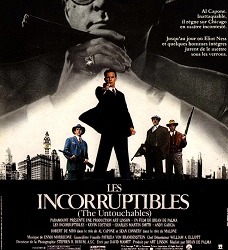
Les Incorruptibles, Brian de Palma :
À Chicago durant les années trente, lors de la prohibition, Al Capone règne en maître absolu sur le réseau de vente illégale d'alcool. Décidé à mettre un terme au trafic et à confondre Al Capone, l'agent Eliot Ness recrute trois hommes de confiance, aussi intraitables que lui. Ensemble, ces quatre incorruptibles partent en guerre contre le gang de Capone.

Élémentaire, ma chère Sarah !, Jô Soares :
1886. L’actrice Sarah Bernhardt fait une tournée triomphale au Brésil. Sommet de son voyage, sa rencontre avec l’Empereur, hélas affligé par le vol du Stradivarius qu’il vient d’offrir à sa maîtresse. Pour Sarah, un seul homme est capable de sortir l’Empereur d’embarras : un étrange Anglais dénommé Sherlock Holmes. Répondant à l’appel de son amie, il débarque à Rio, flanqué de son éternel Watson et affublé de sa casquette à carreaux. Mais la chaleur tropicale, la cuisine épicée, les belles métisses et le cannabis, qui immanquablement vient emplir sa pipe, plongent le célèbre détective dans un brouillard plus épais que le fog londonien.

Nestor Burma : brouillard au Pont de Tolbiac, Tardi, d’après le roman de Léo Mallet :
Alors qu'il se rend en métro à un mystérieux rendez-vous à la Salpétrière, Nestor Burma est abordé par Belita, une jeune Gitane qui le dissuade d'y aller : c'est inutile, l'homme est mort. Mais ce n'est pas un cadavre qui va arrêter notre détective…

La Trilogie Berlinoise, Philip Kerr :
Berlin, 1936 : Bernie Gunther, ex-commissaire de la police berlinoise, est devenu détective privé. Désabusé et courageux, perspicace et insolent, Bernie est un homme solitaire, témoin de son époque. Des rues de Berlin “nettoyées” pour offrir une image idyllique aux visiteurs des Jeux Olympiques à celles de Vienne la corrompue, Bernie enquête... à ses risques et périls.

L’Éclat de Dieu, Romain Sardou :
Plus encore que le Graal ou l’arche d’alliance, l’Éclat de Dieu suscite bien des convoitises depuis la nuit des temps. A celui qui le possède sont en effet promis la compréhension des mystères de l’univers, ainsi que la connaissance et la puissance absolue. Sous couvert d’assurer la protection d’un immense pèlerinage vers Jérusalem, neuf chevaliers francs entreprennent cette audacieuse quête. Mais peu avant le départ, l’un d’eux est assassiné : Cosimo, son neveu, se joint donc à l’expédition pour tenter de découvrir le coupable. Mais Il va devoir redoubler de vigilance et d’habileté pour survivre à cet affrontement de forces qui le dépassent...

1275 âmes, Jim Thompson :
Shérif de Pottsville, 1280 habitants, Texas, au début du vingtième siècle, Nick Corey mène une vie routinière pas trop fatigante dans la mesure où il évite de se mêler des affaires de ses administrés. Débonnaire, apparemment pas très malin, il se laisse même contester et humilier en public. Comme si ça ne suffisait pas, il est cocu et, aux prochaines élections, il pourrait perdre sa place. Il décide donc de commencer à faire le ménage…

L.A. Confidential, James Ellroy :
Trois flics dans le Los Angeles des années 50 : Ed Exley veut la Gloire, Bud White est une bombe à retardement munie d’un badge et Jack Vincennes, dit “Poubelle” terrorise les stars de cinéma pour le compte d’un magazine à scandales. Trois flics, trois hommes pris dans un tourbillon cauchemardesque qui testera leur loyauté, leur courage et le peu d’intégrité qu’il leur reste. Trois flics qui pourraient bien tomber un à un...

Blacksad, tome 2 : Arctic Nation, Juan Díaz Canales & Juanjo Guarnido :
Oldsmill, le maître de la ville, est un tigre blanc. Karup, le chef de la police, un ours blanc. Huk, l'âme damnée de Karup, un renard blanc. Blanc, blanc, blanc, blanc. A leurs yeux, tous les autres habitants, de la pie noire au renard brun-roux en passant par le chat tacheté et la biche châtain, ne sont que racaille. Et si la police n'est pas capable de maintenir l'ordre des blancs, les gros bras d'Arctic-Nation, cagoulés et vêtus de robes blanches, s'en chargent sans états d'âme. Blacksad, chat plus noir que blanc, va devoir se frotter à eux s’il veut retrouver, avant qu’il ne soit trop tard, une petite fille disparue.

L’Aliéniste, Caleb Carr :
New York, 1896... Un meurtrier auprès duquel Jack l’Éventreur fait piètre figure sème aux quatre vents les cadavres d’adolescentes atrocement mutilées, sans provoquer la moindre réaction des pouvoirs publics... Révolté par tant d’indifférence, Théodore Roosevelt, alors préfet, fait appel à ses amis John Schuyler Moore, chroniqueur criminel, et Laszlo Kreizler, spécialiste des maladies mentales, pour élucider cette énigme terrifiante. Leur méthode est révolutionnaire : en étudiant les crimes, ils pensent pouvoir brosser le portrait psychologique de l’assassin, l’identifier et l’arrêter. Mais ils doivent faire vite, car le meurtrier continue de frapper.

Les deniers du Gévaudan, Laetitia Bourgeois :
En octobre 1363, dans le village cévenol de Marcouls, noyé de brouillard et de givre, les paysans luttent quotidiennement pour leur survie. Lorsqu’un collecteur d’impôts est porté disparu, toute la communauté est immédiatement soupçonnée. Mais un jeune habitant du village, Barthélémy, sergent de justice obstiné et risque tout, prend l’affaire en main avec l’aide de son amie Ysabellis, guérisseuse aussi rebelle que talentueuse. Ils n’ont qu’un semaine pour découvrir la vérité, sans quoi les habitants de la vallée seront soumis à la terrible “question” dans les geôles du château seigneurial.

Ostland, David Thomas :
Berlin, 1941. Le jeune et ambitieux Georg Heuser entre dans la police en tant qu’inspecteur à la brigade criminelle. Il est rapidement affecté à la traque d’un tueur en série qui terrorise la ville. Sous la tutelle de son supérieur et mentor, il affirme ses dons d’enquêteur, apprend la loyauté envers ses collègues et jure d’œuvrer toujours au service des innocents. Jusqu’au jour où, pour le récompenser, on le promeut au sein de la SS...
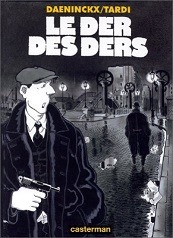
Le Der des Ders, Tardi, d’après un roman de Didier Daeninckx :
Avant guerre, Eugène Varlot s'était frotté à pas mal de petits boulots : mécano, imprimeur, libraire, comédien. Après avoir "fait son devoir" comme tant d'autres pauvres gars embarqués dans la plus grande boucherie de l'Histoire, il se retrouve sur le carreau. Un peu par hasard, il est devenu détective. Installé en ménage avec la belle Irène qui panse à sa manière les blessures de son âme, il accepte ce qu'il croit n'être au début qu'une enquête de routine sur un banal adultère. Son commanditaire : le colonel Fantin de Larsaudière, de l'héroïque 296ème Régiment, le plus médaillé de toute la guerre. Mais Varlot va vite s'apercevoir qu'il sert d'alibi à une sordide histoire de chantage...

Trafic de reliques, Ellis Peters :
Frère Cadfael fait partie d'une délégation religieuse qui se rend au Pays de Galles pour ramener à l'abbaye bénédictine de Shrewsbury les reliques de Sainte Winifred. Les tractations avec les Gallois sont difficiles. Pendant le séjour, Rhisiard, leader de l'opposition au transfert, est assassiné. Immédiatement son pauvre serviteur, amoureux transi de sa fille, est désigné coupable. Mais frère Cadfael n’est pas de cet avis, et se prépare à mener l’enquête...

Penelope Green, tome 1 : La Chanson des enfants perdus, Béatrice Bottet :
Penelope Green, unique héritière du journaliste James Alec Green, décide de reprendre une enquête de son père : le mystérieux dossier FOXGLOVE COURT. Quel terribles secrets va-t-elle découvrir dans les bas-fonds de Londres ?

La Table des matières, Sylvie Fayet-Scribe :
Qui a torturé puis assassiné Margaret Penfield, respectable bibliothécaire américaine ? Et pourquoi ? Avait-elle identifié la plante qui promet l'immortalité décrite par Hildegarde de Bingen au XIIe siècle ? Pour Laurette Lerbier, révéler au grand public le nom de cette plante fabuleuse serait le point d'orgue de l'exposition sur les jardins qu'elle prépare au Muséum d'histoire naturelle de Paris. Elle se lance donc à la recherche de l'énigmatique source de jouvence. L'enquête la mène dans le monde méconnu des précurseurs d'Internet. Des savants de la Renaissance aux encyclopédistes-mondialistes de la fin du XIXe siècle, en passant par les jansénistes de Port-Royal et les bibliographes révolutionnaires du siècle des Lumières, le but de sa quête ne cesse de se dérober alors que les menaces se font plus précises. Accompagnée de Lucas du Prat, savant botaniste de la police scientifique, Laurette trouvera-t-elle les clefs du mystère ?
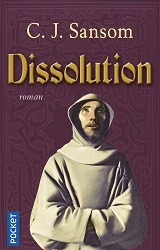
Dissolution, C.J. Sansom :
En 1557, l’Angleterre est déchirée par une violente période de transition religieuse : les réformistes s’apprêtent à dissoudre tous les anciens monastères catholiques, coupables, selon eux, d’idolâtrie obscurantiste. C’est dans cette atmosphère chaotique que Matthew Shardlake, brillant avocat, est reçu au cabinet de Lord Crommwell, chef des réformistes. Ce dernier le somme de se rendre au monastère de Scarnsea, théâtre de rumeurs sordides, dans lequel Shardlake va découvrir le cadavre décapité d’un confrère... Un assassinat inexplicable, des traces de rituel païen, une congrégation frappée de mutisme : l’avocat devra résoudre, une à une, toutes les facettes de cette macabre énigme.

Meurtres à la pomme d’or, Michèle Barrière :
An de grâce 1556 : François, étudiant en médecine à Montpellier, n’a qu’une idée en tête : devenir cuisinier. Aux dissections, il préfère l’étude du safran, de la cardamone, du gingembre, du macis et autre maniguette sous la houlette de l’apothicaire Laurent Catalan. Mais une série de morts suspectes sème le trouble dans la ville. Un mystérieux breuvage distribué par un apothicaire ambulant en est la cause. Laurent Catalan, en raison de ses origines juives et de ses sympathies pour les protestants, est accusé de complicité et jeté en prison. François mène l’enquête jusqu’à Bologne. Parviendra-t-il à sauver son mentor ?

L’Affaire de l’auberge rouge, Stéphane de Caneva, Julien Moca & Didier Quella-Guyot :
Plateau de Peyrebeille, campagne ardéchoise, dans les années 1830. Pierre et Marie Martin sont aubergistes. Les rumeurs les plus folles courent sur leur compte ! On les accuse de détrousser et d'assassiner leurs clients. D'ailleurs, comment pourrait-il en être autrement au regard de la fortune qu'ils ont accumulée en si peu de temps ? Et leur valet les aide, à tous les coups ! La vindicte populaire a tranché, on doit juger et condamner les Martin. De toute façon, ils sont coupables, tout le monde le sait. Ou l’a décidé, ce qui revient au même...

Un Fleuve de ténèbres, Rennie Airth :
Nous sommes en 1921, et le jeune Billy Styles va voir ses débuts dans la police marquée par une horrible expérience. Dans un manoir de la campagne du Surrey, on vient de découvrir les corps ensanglantés du colonel Fletcher, de sa femme Lucy et de deux de leurs domestiques, sauvagement poignardés. Pour les policiers du Surrey, ces meurtres sont le résultat d’un cambriolage qui aurait mal tourné. Appelé de Scottland Yard en renfort, l’inspecteur Madden voit les choses différemment : ce crime, il en est sûr, est l’œuvre d’un psychopathe qui frappera à nouveau. Sans tarder.

Le Serpent de feu, Fabrice Bourland :
Tandis que les rues de Londres déploient tous leurs atouts pour le couronnement prochain de George VI, les détectives Singleton et Trelawney se retrouvent lancés sur les traces d’une momie mystérieusement disparue. Une affaire d’autant plus insolite qu’elle semble liée au meurtre d’un politicien qui met tout Scottland Yard en alerte... En ces jours où la ville entière est à la fête, les morts s’aviseraient-ils de se relever de leur sépulcre pour se mêler des affaires des vivants ?
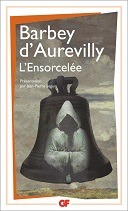
L’Ensorcelée, Jules Barbey d’Aurevilly :
Les lendemains de la Chouannerie. Dans une atmosphère de campagne barbare où interviennent des pâtres jeteurs de sorts et des vieilles femmes hantées par le souvenir de leurs débauches, Jeanne Le Hardouey est “ensorcelée” par un prêtre, l’abbé de La Croix-Jugan, dont le visage porte de terribles cicatrices. Lorsqu’on retrouve Jeanne noyée, les tensions se cristallisent et la mort frappe à nouveau...

Breaking the wall, Claire Gratias :
Juillet 1989. A Berlin-Est, Markus Schloss se réfugie dans un mutisme incompréhensible tandis que Klaus Weber, qui vit à l’Ouest, se laisse convaincre par une jeune documentariste française de raconter pour la première fois son passé. Mais pour comprendre le lien entre les deux hommes, il faut connaître l’histoire d’Anna...
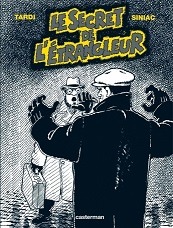
Le Secret de l’étrangleur, Tardi, d’après un roman de Pierre Siniac :
Paris, 1959. Dans la capitale plongée en plein brouillard, un étrange étrangleur rôde. Mais que fait la police ? Elle fait grève, permettant ainsi à l'étrangleur d'accomplir ses odieux forfaits. Tardi délaisse le Nestor Burma de Léo Malet pour mettre en scène sa vision de Monsieur Cauchemar, un roman signé Pierre Siniac. Humour noir, dénouement à tiroirs et pavés luisants : du grand Tardi !

Le Nom de la rose, Umberto Eco :
En arrivant dans le havre de sérénité et de neutralité que devrait être cette abbaye – admirée de tout l'Occident pour la science de ses moines et la richesse de sa bibliothèque, l'ex-inquisiteur Guillaume de Baskerville, accompagné de son secrétaire Adso de Melk, se voit prié par l'Abbé de découvrir au plus vite ce qui a poussé un de ses moines à se fracasser les os au pied des vénérables murailles. C'est le premier des sept morts qui seront scandés par les heures canoniales de la vie monastique. Ces décès tragiques sont-ils un signe divin de l’apocalypse à venir ? Où sont-ils les résultats de machinations bien humaines ?

Le Nom de la rose, Jean-Jacques Annaud :
Sous la direction de Jean-Jacques Annaud, le célèbre roman lyrique d'Umberto Eco se mue en palpitant thriller gothique. Dans une atmosphère d’ombres grotesques et de faux-semblants, Sean Connery campe un surprenant apôtre de la Vérité face à ses confrères obscurantistes et sans scrupules.
4 notes
·
View notes
Text
L’exposition Trésors de Venise la Collection Cini
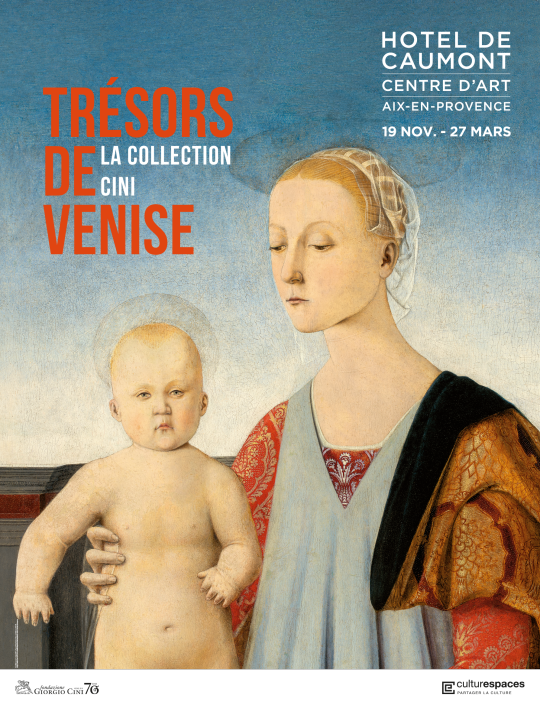
A l’Hôtel de Caumont Centre d’Art à Aix-en-Provence du 19 novembre 2021 au 27 mars 2022
À l’occasion du 70e anniversaire de la création de la Fondation Giorgio Cini, nous vous proposons un voyage à Venise en présentant pour la première fois hors d’Italie des chefs-d’œuvre de la collection Cini, l’une des plus importantes collections d’art ancien italien.
Les 70 peintures, sculptures, dessins et objets précieux présentés font partie de l’un des plus prestigieux ensembles d’art italien, du XIVe au XVIIIe siècle, réuni par l’entrepreneur et philanthrope Vittorio Cini (Ferrare 1885 – Venise 1977). Sa curiosité insatiable et les conseils avisés d’historiens de l’art prestigieux lui ont permis, en l’espace de 50 ans environ, de former une collection exceptionnelle tant par sa qualité que par la variété de techniques et de typologies d’objets. On y trouve des sculptures, gravures, dessins, objets de mobilier et des peintures sur bois ainsi que des porcelaines vénitiennes et des ivoires français, des miniatures et des volumes finement décorés.
En 1951, le collectionneur créa la Fondation Giorgio Cini, centre de recherche et formation de réputation internationale, à la mémoire de son fils, décédé prématurément. Aujourd’hui, la collection Cini se répartit entre la Galerie du Palazzo Cini, ancienne résidence du collectionneur sur le Canal Grande, et le siège de la Fondation Giorgio Cini, sur l’île de San Giorgio Maggiore.
Aux côtés des grands noms de la peinture toscane - comme Fra Angelico, Filippo Lippi, Piero di Cosimo, Jacopo da Pontormo - et vénitienne, comme Lorenzo et Giandomenico Tiepolo, l’exposition présente des pièces maîtresses de la Renaissance ferraraise. Complétée par une sélection de sculptures, émaux et ivoires, ainsi que par un choix de dessins et enluminures, l’exposition rend compte de toute la variété stylistique de l’art italien.
L’exposition présente également des créations contemporaines en dialogue avec les œuvres de la collection. Ces créations des artistes Ettore Spalletti ou encore Vik Muniz, réalisées à l’origine pour être exposées dans la Galerie du Palazzo Cini, témoignent du fait que la collection Cini est une source d’inspiration inépuisable pour les artistes d’aujourd’hui.
Pour réserver vos places : Billetterie | Hôtel de Caumont (tickeasy.com)
0 notes
Photo

MEDICI.
I Medici (Medici) è una serie televisiva anglo-italiana creata da Frank Spotnitz e Nicholas Meyer, trasmessa dal 18 ottobre 2016 all'11 dicembre 2019
su Rai 1 per tre stagioni e 24 episodi.
La serie descrive l'ascesa della famiglia Medici, casata a capo della città di Firenze durante il Rinascimento, e le numerose traversie
affrontate dalla stessa con le altre famiglie rivali e i tentativi di spodestamento. Essa trae ispirazione da fatti, persone ed eventi
realmente avvenuti ed esistiti, seppur romanzati per rendere più appetibili le vicende al pubblico televisivo.
Il protagonista della prima stagione (Medici: Masters of Florence) è Cosimo de' Medici, interpretato da Richard Madden,
succeduto al padre come capo della famiglia e che insieme al fratello Lorenzo, interpretato da Stuart Martin, dovrà dimostrare
di essere all'altezza del compito affidatogli dal padre.[1] Tra gli altri interpreti principali figurano Dustin Hoffman,
Guido Caprino, Alessandro Sperduti, Annabel Scholey, Lex Shrapnel, Frances Barber, Alessandro Preziosi, Sarah Felberbaum e Brian Cox.
La seconda stagione (Medici: The Magnificent) in italiano si chiama I Medici - Lorenzo il Magnifico e vede come protagonista appunto il nipote di Cosimo,
Lorenzo de' Medici detto il "Magnifico", interpretato da Daniel Sharman. Il titolo della terza stagione è I Medici - Nel nome della famiglia.
La serie è stata diffusa in Italia da Rai 1 dal 18 ottobre 2016, e gli otto episodi della prima stagione sono stati anche trasmessi nello standard 4K HDR sul
canale Rai 4K: fu la prima volta nella storia della televisione italiana che una serie televisiva venne trasmessa in Ultra HD.
Lo stesso giorno della messa in onda del primo episodio, la Rai pubblicò in anteprima sul portale Rai Play i primi cinque minuti dell'episodio.
La seconda stagione è stata trasmessa dal 23 ottobre 2018. La terza stagione conclusiva è andata in onda dal 2 all'11 dicembre 2019.
La sigla dei titoli di testa della prima stagione è Renaissance, cantata da Skin, mentre la sigla della seconda e della terza stagione
è Revolution Bones, una variazione di Renaissance della stessa cantante.
Parliamo di un altra serie che mi piace molto questa volta e una serie italiana strano detto da me considerando che non amo molto le serie tv
italiane o i film italiani,non e per male ma non sono il mio genere comunque la serie di cui voglio parlare e i medici, una serie davvero molto
carina che l'ho scoperta perchè c'era l'attore che mi piaceva tanto comunque la serie veniva trasmessa su Rai uno poi e uscita in streaming,
le due stagioni che ho visto tranne la prima le ho viste su Rai uno invece la prima stagione in streaming, devo dire che l'ho adorata fin dal primo
momento gli attori sono meravigliosi, in più la sigla e bellissima cantata da Skin e una sigla bellissima sono innamorata di quella canzone, la
serie e una serie storica ma c'è anche un pizzico di romanticismo specialmente alcune scene di sesso, parla della storia dei Medici una casata italiana che
nel corso della storia ha fatto molte cose importanti tra cui ci sono anche molti artisti famosi nel mondo che nel corso della storia si conosceranno, parliamo di
una serie dove c'è l'arte italiana che e bellissima, mamma mia ci sono posti in Italia che sono bellissimi che consiglio di visitare infatti un giorno spero
di andarci, la storia l'arte e davvero una serie bellissima,in tutto sono tre stagioni ogni stagione e bellissima. Parlando di personaggi che mi piacciono,
diciamo tutti quanti apparte quelli che sono contro i medici mi fanno venire una rabbia anche se nella seconda stagione c'è un personaggio che provi sia amore che
rabbia non posso dirvi molto perchè non voglio fare spoiler, parlando di personaggi un personaggio che mi piace e Cosimo dei Medici anche se diciamo che ha fatto
vari errori posso dire che non e stato un santo ma devo dire che mi piace molto, un altro personaggio che mi piace e Contessina cavolo adoro quella donna anche se
quel periodo le donne non venivano considerate cosi tanto lei invece e una donna forte che sa bene quello che vuole e una donna che lotta sia per l'amore ma anche
per la famiglia e una donna fantastica posso dire che nella serie le donne sono davvero forti parliamo di donne che lottano sia per l'amore ma anche per loro
stesse trovo pazzesco il girl power che c'è nella serie anche se il periodo era difficile, un altro personaggio che mi piace e anche nella seconda stagione e Lorenzo
il Magnifico anche lui nella sua vita ha combinato molti casini posso dire che non e un santo ma cavolo il suo personaggio e davvero forte infatti mi piace anche lui,
poi gli attori che recitano i personaggi sono fantastici hanno davvero bravi, un altro personaggio che mi piace molto e Clarice, un personaggio anche lei molto forte
anche se Lorenzo ha fatto molti errori con lei devo dire che lei e davvero forte una donna che non si piega al volere degli altri neanche al volere del marito,
mi piace molto anche Giuliano e la sua storia sono Simonetta mamma mia la loro storia e cosi dolce che fa piangere, le principali storie d'amore che ci sono sono
bellissime posso dire che sia nel bene che nel male vi fanno emozionare, ci sono molte scene che mi piacciono specialmente alcune, credo che la prima stagione e forse
la più bella anche le altre due sono pazzesche ma forse la prima ha quel punto in più specialmente nella storia d'amore. Sono stati fatti tre libri che riprendono
anche la serie tv infatti ho comprato tutti e tre i libri più uno che non c'entra niente con la storia, ero cosi curiosa sono anche i primi libri storici che compro
di solito compro solo storie romantiche ma posso dire che non sono male e che mi piacciono molto. Credo che la serie avrebbe dovuto avere più spazio diciamo conosciuta
di più non so e come se non gli hanno dato quel importanza che merita, infatti speravo che Daniel Sharman l'attore che interpreta Lorenzo vinceva almeno un premio
perchè e davvero bravo posso dire che ci sono delle scene che vi faranno piangere e anche emozionare, dei momenti di rabbia ma anche di dolore non faccio spoiler ma
davvero questa serie merita davvero tanto e consiglio a tutti quanti di vederla se non l'avete ancora vista, ci sono degli attori che sono bravissimi, ci sono scene
bellissime e parla anche della storia italiana tra cui anche l'arte che merita davvero tanto, la potete trovare in vari siti di streaming purtroppo non la fanno più
in tv anche se spero un giorno che la trasmettono su Netflix.
0 notes
Text
Il cambio di comando al Corpo delle Capitanerie di Porto: Carlone subentra a Pettorino

Cambio comando Guardia Costiera
Cambio comando Guardia Costiera
Cambio comando Guardia Costiera
Cambio comando Guardia Costiera
Cambio comando Guardia Costiera
Cambio comando Guardia Costiera
Cambio comando Guardia Costiera
Cambio comando Guardia Costiera
Cambio comando Guardia Costiera
Cambio comando Guardia Costiera
Cambio comando Guardia Costiera
Cambio comando Guardia Costiera
Cambio comando Guardia Costiera
Cambio comando Guardia Costiera
Cambio comando Guardia Costiera Cambio di comando Capitaneria di Porto
https://youtu.be/Dzw-Glb7IPs
Video
Venerdì 23 luglio, nel piazzale interno del Comando Generale, si è tenuta la cerimonia del passaggio di consegne al vertice del Corpo delle Capitanerie di porto – Guardia Costiera, tra l'Ammiraglio Ispettore Capo Giovanni Pettorino, che lascia per raggiunti limiti di età, e l'Ammiraglio Ispettore Capo Nicola Carlone, che assume l’incarico dopo aver rivestito quello di Direttore Marittimo della Liguria. All'evento hanno preso parte il Ministro della Difesa Lorenzo Guerini, il Ministro delle Infrastrutture e della mobilità sostenibili, Enrico Giovannini, il Capo di Stato Maggiore della Difesa, Generale Enzo Vecciarelli e quello della Marina Militare Ammiraglio di Squadra Giuseppe Cavo Dragone, i quali hanno voluto esprimere il loro sentito apprezzamento per gli eccellenti risultati raggiunti dal Corpo alla guida dell’Ammiraglio Pettorino e piena fiducia nelle competenze e nella lunga esperienza, in particolare sugli scenari internazionali, dell’Ammiraglio Carlone. Tra le numerose autorità presenti alla cerimonia, anche i Vertici delle altre Forze Armate, delle Forze di Polizia e degli altri Corpi dello Stato. Dopo la consueta rassegna dei reparti, schierati per l’occasione in grande uniforme, il trasferimento di incarico è stato suggellato dalla rituale formula di riconoscimento pronunciata dall'Ammiraglio Pettorino. Nel suo intervento di commiato, Pettorino ha ripercorso il suo lungo periodo alla guida del Corpo sottolineando la fiducia che gli italiani hanno recentemente manifestato verso la Guardia Costiera: “fiducia che le Capitanerie di porto hanno saputo costruire e meritare in questi 156 anni della loro storia; una conferma dell’apprezzamento che il nostro lavoro riscuote tra la gente, conquistata sul campo nei 288 presidi sul territorio”. Rivolgendosi al suo successore, l’Ammiraglio Pettorino ha riconosciuto l’amore per il Corpo e per “la sua risorsa più preziosa: i suoi uomini e le sue donne” che anche nei momenti più complicati hanno consentito di tenere il timone e la barra al centro: “con quella saldezza d’animo e quella generosità che ogni giorno mettete a disposizione del nostro Paese, con disciplina e onore.” E' seguito uno dei momenti più suggestivi della cerimonia: dopo l'ammaina del vessillo dell'Ammiraglio Pettorino, è stato issato quello dell'Ammiraglio Carlone, quale ideale passaggio di testimone. Nella sua allocuzione, l’Ammiraglio Carlone ha ringraziato le istituzioni presenti, sentendosi onorato della loro fiducia e considerazione, nonché le altre autorità militari e civili, a testimoniare un’autentica vicinanza al Corpo:“vicinanza che mi da la forza per assumere al meglio il mio incarico e le conseguenti responsabilità. Ringrazio i comandanti generali che mi hanno preceduto e che mi hanno testimoniato affetto e vicinanza. Assicuro che il mio impegno sarà rivolto, nella continuità, a rafforzare il ruolo del Corpo nel Ministero delle Infrastrutture e della mobilità sostenibili, dal quale dipendiamo, non solo per funzioni, ma anche in virtù di un solido vincolo di bilancio, a sostegno di quella marittimità che, senza retorica, rappresenta oggi, più che mai, una delle risorse più preziose del Paese e della sua economia.”L’evento è stato raccontato in diretta sul canale youtube della Guardia Costiera dal vice direttore del TG1 Filippo Gaudenzi e dal Capo Ufficio Comunicazione del Comando Generale Capitano di Vascello Cosimo Nicastro Il passaggio di consegne è stata un’occasione per ricordare le numerose attività che le Capitanerie di Porto – Guardia Costiera, Corpo della Marina Militare, hanno svolto nel triennio del mandato di vertice in scadenza. Compiti numerosi e delicati, svolti alle dipendenze funzionali dei Ministeri delle Infrastrutture e della mobilità sostenibili, della Transizione ecologica, delle Politiche Agricole, Alimentari e Forestali; un Corpo che si ponecome punto di riferimento imprescindibile per tutta l’utenza del mare, nel saper coniugare, sempre, sicurezza e umanità. Un’organizzazione efficiente e capillare che in questi anni difficili di emergenza pandemica ha garantito l’efficienza e la continuità di tutti gli approvvigionamenti via mare dei beni essenziali, la sicurezza e la regolarità dei trasporti marittimi, mai interrotti.
Read the full article
0 notes
Photo

Canale navigabile Pisa-Livorno detto “dei Navicelli” Le prime notizie del canale dei Navicelli che partendo a valle della città di Pisa giunge a Livorno risalgono alla fine del XVI secolo, all’epoca di Cosimo I de’ Medici, quando Pisa e Livorno erano ormai sotto il dominio di Firenze.
#Canale dei Navicelli#Canale navigabile Pisa-Livorno#collegamenti fluviali#porti fluviali in Toscana
0 notes